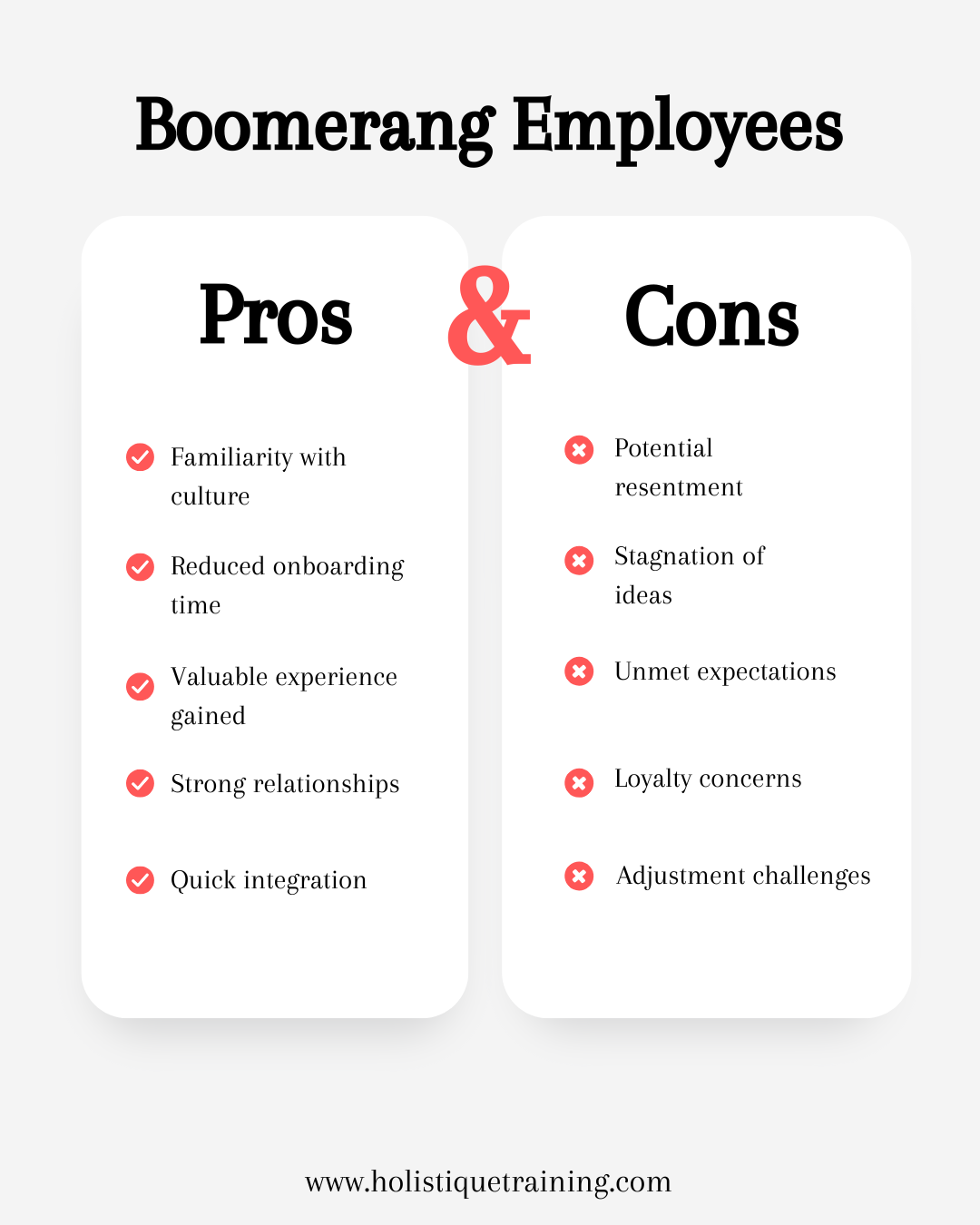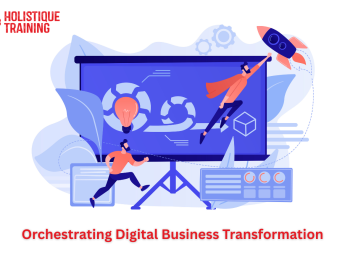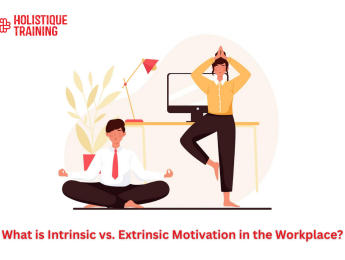- Table of Contents
- Introduction
- What is a Boomerang Employee?
- Why Do Former Employees Return?
- Positive Work Environment:
- Career Advancement:
- Stronger Connections:
- Work-Life Balance:
- Company Reputation:
- Desire for Stability:
- Unfulfilled Expectations:
- Desire for Change:
- Benefits of Rehiring Former Employees
- Familiarity with Company Culture:
- Reduced Onboarding Time:
- Enhanced Skill Sets:
- Stronger Loyalty and Commitment:
- Positive Impact on Morale:
- Cost-Effectiveness:
- Reduced Turnover Rates:
- Knowledge Retention:
- Networking and External Insights:
- Diversity of Experience:
- Pros and Cons of Boomerang Employees
- Pros
- Stronger Loyalty:
- Positive Impact on Morale:
- Enhanced Innovation:
- Cons
- 4 Essential Interview Questions for Boomerang Employees
- 1- What motivated you to return to our company?
- 2- What have you learned during your time away that can benefit our team?
- 3- How do you envision your role evolving if you return?
- 4- How do you plan to address any challenges you faced during your previous tenure?
- When Should You Reconsider Hiring a Former Employee?
- 7 Strategies for Hiring Boomerang Employees
- 1. Maintain Positive Relationships
- 2. Conduct Exit Interviews
- 3. Create an Alumni Network
- 4. Promote a Positive Employer Brand
- 5. Leverage Employee Referrals
- 6. Assess Skills and Fit
- 7. Provide a Clear Path for Reintegration
- Conclusion
Introduction
The modern workplace is evolving rapidly, influenced by shifting employee expectations and the dynamics of talent acquisition. One significant trend that has emerged in recent years is the phenomenon of "boomerang employees." These are individuals who leave a company only to return later, often bringing valuable experience and fresh perspectives. This blog post delves into the concept of boomerang employees, exploring their motivations for returning, the benefits and challenges they present to organizations, and effective strategies for successfully integrating them back into the workforce. By understanding this trend, companies can make informed decisions about their hiring practices and foster a more resilient workforce.
What is a Boomerang Employee?
A boomerang employee is someone who has previously worked for a company, left for various reasons, and later returned to the same organization. This trend has gained traction as more individuals recognize the value of their previous experiences and the relationships they built within their former workplaces. Boomerang employees can be found across various industries, from technology to retail, and their return can often signify a mutual benefit for both the employee and the employer.
The rise of boomerang employees reflects broader changes in the employment landscape. With the gig economy on the rise and job-hopping becoming more commonplace, many workers are seeking diverse experiences that can enhance their skills and career trajectories. However, not all departures are permanent. Many former employees maintain connections with their old colleagues and company culture, making it easier for them to return when the time is right.
Why Do Former Employees Return?
Understanding why former employees choose to return is crucial for organizations looking to leverage this trend. Several factors contribute to the decision to rejoin a previous employer:
Positive Work Environment:
One of the most compelling reasons former employees return is the positive work culture they experienced during their tenure. Many individuals leave their jobs seeking better opportunities or new challenges, but if they find that their new workplace lacks the supportive and inclusive environment they once enjoyed, they may yearn to return. A strong sense of community, open communication, and a collaborative spirit can be significant draws for those considering a comeback.
Career Advancement:
When employees leave a company, they often seek to broaden their horizons, gain new skills, or pursue advancement in their careers. However, upon reflection, they may realize that their previous employer offers better opportunities for growth and development. Returning employees can leverage their newfound skills and experiences to take on more advanced roles, making them attractive candidates for promotions or leadership positions. Interestingly, boomerang employees enjoy an average pay raise of 25%, compared to just 4% for those who remain with a single company. This opportunity for upward mobility and significant salary increases can be a strong incentive to rejoin a familiar organization.
Stronger Connections:
The relationships built during their initial tenure play a crucial role in an employee's decision to return. Many former employees maintain friendships and professional networks with their colleagues, which can create a sense of belonging and loyalty. When they leave, they may miss the camaraderie and teamwork that defined their previous experience. Notably, the average employee tenure with a company has remained aroundfive years for the past 40 years. This relatively short duration often leads former employees to seek reconnection with colleagues, making the desire to reintegrate into a familiar team a powerful motivator for returning to a former employer.
Work-Life Balance:
The pursuit of a better work-life balance is a common reason for employees to leave their jobs. If a former employer has made significant strides in promoting flexibility, remote work options, or improved benefits since their departure, it can entice former employees back. Many individuals are now prioritizing their well-being and personal lives more than ever, and a company that demonstrates a commitment to work-life balance can be particularly appealing.
Company Reputation:
The reputation of a company plays a vital role in attracting former employees back. If a company is known for its positive culture, employee development programs, and strong leadership, former employees may be more inclined to return. Additionally, changes in leadership or corporate strategy that align with an employee's values or career goals can create an inviting atmosphere for former employees to reconsider their previous employer.
Desire for Stability:
In an increasingly volatile job market, many individuals are seeking stability and security in their careers. If a former employee has experienced job instability or uncertainty in their new role, they may view their previous employer as a more secure option. The familiarity of the workplace, combined with a stable company environment, can be a compelling reason for them to return.
Unfulfilled Expectations:
Sometimes, employees leave with high hopes for their new roles, only to find that the reality does not meet their expectations. This disillusionment can lead them to reconsider their previous position, especially if they had a positive experience before leaving. Recognizing that their former employer may offer a better fit for their skills and aspirations can prompt them to return.
Desire for Change:
Ironically, the very act of leaving a job can lead to a desire for change. Former employees may have left seeking new challenges or experiences, but after exploring different opportunities, they might realize that they prefer the stability and familiarity of their previous role. This desire for change can manifest as a longing to return to a comfortable and known environment.
By understanding these motivations, organizations can create an environment that encourages former employees to consider returning. Tailoring recruitment strategies to address these factors can enhance the likelihood of attracting boomerang employees and reaping the benefits of their unique insights and experiences.
Benefits of Rehiring Former Employees
Rehiring former employees can offer numerous advantages for organizations. Here are some of the key benefits:
Familiarity with Company Culture:
One of the most significant advantages of rehiring former employees is their inherent understanding of the company culture. They have already navigated the organizational landscape, which means they are familiar with the values, mission, and unwritten rules that define the workplace. This familiarity allows for a smoother reintegration process, as these employees can quickly adapt to the existing team dynamics and contribute effectively without the lengthy onboarding required for new hires.
Reduced Onboarding Time:
Boomerang employees typically require less time to acclimate to their roles compared to new hires. Since they already understand the company's processes, systems, and culture, they can hit the ground running. This reduction in onboarding time not only saves the company resources but also allows the employee to become productive more quickly, benefiting both the team and the organization as a whole.
Enhanced Skill Sets:
When former employees return, they often bring with them new skills and experiences gained during their time away. Whether they have worked in different industries, taken on new responsibilities, or acquired additional qualifications, these new insights can lead to innovative ideas and improvements in processes. Their fresh perspective can help the organization adapt to changing market conditions and enhance overall performance.
Stronger Loyalty and Commitment:
Employees who choose to return to a previous employer often exhibit a stronger sense of loyalty and commitment. Their decision to come back indicates a genuine appreciation for the organization and its culture. This loyalty can translate into higher levels of engagement and motivation, which can positively influence team morale and productivity. Boomerang employees may also be more willing to go the extra mile, knowing that they have a vested interest in the company’s success.
Positive Impact on Morale:
The return of a boomerang employee can serve as a morale booster for the entire team. It demonstrates that the company values its employees and is open to welcoming them back, reinforcing a sense of community and belonging. This positive reinforcement can encourage other employees to stay engaged and committed, knowing that their contributions are recognized and valued.
Cost-Effectiveness:
Hiring former employees can be a cost-effective strategy for organizations. The recruitment process can be time-consuming and expensive, involving advertising, interviewing, and training new hires. In contrast, rehiring former employees can reduce these costs, as they may require less training and onboarding. Additionally, the organization can save on recruitment fees and resources typically associated with hiring new talent. For instance, one company found that increasing their rehire rate from 2.4% to 8% through an alumni program resulted in savings of$1.25 million, highlighting the significant financial benefits of bringing back former employees.
Reduced Turnover Rates:
Bringing back former employees can help mitigate turnover rates. Employees who leave but return often do so with a clearer understanding of their career goals and a renewed commitment to the organization. This can lead to greater job satisfaction and lower turnover rates, ultimately benefiting the company by maintaining a stable and experienced workforce.
Knowledge Retention:
When former employees return, they bring back valuable institutional knowledge that can be difficult to replace. This knowledge includes an understanding of past projects, client relationships, and internal processes that contribute to the organization's success. By rehiring these individuals, companies can retain critical knowledge that might otherwise be lost, enhancing continuity and performance.
Networking and External Insights:
Former employees often maintain professional networks that can be beneficial to their returning employer. They may have developed connections with industry peers, clients, or vendors that can provide valuable insights and opportunities. This expanded network can lead to new partnerships, collaborations, and business opportunities, further strengthening the organization.
Diversity of Experience:
Rehiring former employees who have explored other opportunities can introduce a diversity of experience and thought into the organization. They may bring new ideas and perspectives that can drive innovation and creativity within teams. This diversity can be particularly beneficial in problem-solving and decision-making processes, as it encourages a broader range of viewpoints and solutions.
In summary, the benefits of rehiring former employees extend far beyond simply filling a position. By leveraging their familiarity with the organization, enhanced skill sets, and strong commitment, companies can create a more dynamic and resilient workforce. Recognizing and embracing the value of boomerang employees can ultimately lead to improved performance, employee satisfaction, and organizational success.
Criteria | Former Employees | New Hires |
Onboarding Time | Shorter, familiar with culture | Longer, requires training |
Cost of Hiring | Lower, reduced recruitment fees | Higher, includes advertising and interviewing |
Performance Ramp-Up | Quicker, leveraging prior experience | Slower, needs time to adjust |
Cultural Fit | Already understands company values | May need time to adapt |
Retention Risk | Potential loyalty concerns | Uncertain, depends on fit |
Pros and Cons of Boomerang Employees
While there are many benefits to rehiring former employees, there are also potential drawbacks. It’s essential to weigh the pros and cons before making hiring decisions.
Pros
Experience and Knowledge:
Boomerang employees come equipped with valuable experience and knowledge of the company’s operations, processes, and culture. This familiarity allows them to integrate more quickly into their roles and contribute effectively from day one. Their prior experience can also help them navigate challenges and mentor newer employees, enhancing overall team performance.
Cultural Fit:
Since former employees are already acquainted with the company’s culture, they are likely to be a better fit than new hires who may need time to adjust. This cultural alignment can lead to improved teamwork and collaboration, as they understand the dynamics and expectations within the organization.
Reduced Recruitment Costs:
Hiring boomerang employees can be more cost-effective compared to recruiting entirely new talent. Organizations can save on recruitment advertising, agency fees, and extensive training programs, as these employees often require less onboarding. This financial efficiency can be particularly beneficial for companies looking to optimize their hiring processes.
Stronger Loyalty:
Employees who return to a former employer often exhibit a heightened sense ofloyalty and commitment. Their decision to come back indicates a genuine appreciation for the organization and its culture. This loyalty can lead to increased engagement, motivation, and a willingness to contribute positively to the company’s success.
Positive Impact on Morale:
The return of a boomerang employee can boost morale among existing staff. It signals that the organization values its employees and fosters a supportive environment. This positive reinforcement can encourage current employees to remain engaged and motivated, knowing that their contributions are recognized and appreciated.
Enhanced Innovation:
Boomerang employees often return with new skills, perspectives, and insights gained from their time away. This diversity of experience can fosterinnovation within the organization, as these employees may introduce fresh ideas and approaches that can drive improvements in processes and products.

Cons
Potential Resentment Among Current Employees:
One of the significant drawbacks of rehiring former employees is the potential for resentment among current staff. If existing employees feel overlooked for promotions or opportunities in favor of returning colleagues, it can lead to dissatisfaction and decreased morale. This situation may create an environment of competition rather than collaboration.
Stagnation of Ideas:
Relying too heavily on boomerang employees can lead to stagnation in creativity and innovation. While these employees bring valuable experience, they may also be inclined to replicate past practices rather than challenge the status quo. This tendency can hinder the organization’s ability to adapt to changing market conditions and embrace new ideas.
Risk of Departure Again:
There is always a risk that a boomerang employee may leave the organization again. If their reasons for leaving initially have not been adequately addressed or if they still seek different opportunities, their return may be temporary. This potential instability can create uncertainty within teams and impact overall productivity.
Cultural Misalignment:
Although boomerang employees are generally familiar with the company culture, significant changes within the organization since their departure may lead to cultural misalignment. If the company has evolved in response to new challenges or shifts in strategy, returning employees may struggle to adapt to these changes, which can affect their effectiveness in their roles.
Reinforcement of Negative Behaviors:
If a former employee left due to performance issues, a toxic attitude, or other negative behaviors, their return could reinstate those challenges within the team. It’s essential for organizations to assess whether the underlying issues that led to their departure have been resolved before bringing them back on board.
Overemphasis on Familiarity:
While familiarity can be an advantage, it can also lead to complacency in hiring practices. Organizations may become overly reliant on former employees, neglecting to seek out diverse talent that can bring new perspectives and ideas. This overemphasis on familiarity can limit the organization’s ability to innovate and grow.
In summary, the decision to rehire boomerang employees involves careful consideration of both the advantages and potential drawbacks. By weighing these factors and implementing thoughtful hiring practices, organizations can maximize the benefits of bringing back former employees while mitigating the risks associated with their return. This balanced approach can lead to a more engaged, innovative, and resilient workforce.
4 Essential Interview Questions for Boomerang Employees
When interviewing boomerang employees, it’s crucial to ask questions that assess their motivations for returning and their readiness to reintegrate. Here are four essential questions to consider:
1- What motivated you to return to our company?
This question helps gauge the candidate’s reasons for coming back and whether they align with the company’s values.
2- What have you learned during your time away that can benefit our team?
This allows the candidate to showcase any new skills or insights they’ve gained, emphasizing their potential contributions.
3- How do you envision your role evolving if you return?
Understanding their expectations for growth and development can help ensure alignment between the employee’s goals and the company’s needs.
4- How do you plan to address any challenges you faced during your previous tenure?
This question encourages candidates to reflect on their past experiences and demonstrate their commitment to overcoming obstacles.
When Should You Reconsider Hiring a Former Employee?
While many boomerang employees can bring significant benefits, there are circumstances where reconsideration may be warranted. Here are a few situations to keep in mind:
- Previous Performance Issues: If the former employee had performance-related problems during their last tenure, it’s essential to assess whether those issues have been resolved or if they are likely to recur.
- Cultural Misalignment: If the employee left due to a mismatch with the company culture, their return may not be in the best interest of either party.
- Changes in Company Direction: If the company has undergone significant changes in strategy or leadership since the employee’s departure, it’s crucial to evaluate whether they will fit into the new environment.
- Lack of Commitment: If the former employee left without a clear reason or expressed dissatisfaction with their previous role, it may indicate a lack of commitment to the organization.
7 Strategies for Hiring Boomerang Employees
Rehiring former employees, or boomerang employees, can be a strategic advantage for organizations. However, to maximize the benefits and ensure a successful reintegration, companies should adopt specific strategies when considering these candidates. Here are seven effective strategies for hiring boomerang employees:
1. Maintain Positive Relationships
Keeping in touch with former employees is crucial for encouraging future rehires. Organizations should foster positive relationships even after an employee leaves. This can be achieved through regular check-ins, alumni networks, or social media engagement. By maintaining these connections, companies can create a welcoming environment that encourages former employees to consider returning.
2. Conduct Exit Interviews
When employees leave, conducting thorough exit interviews can provide valuable insights into their reasons for departing. Understanding their motivations can help organizations address any issues and improve the work environment. Additionally, exit interviews can reveal whether the employee might be interested in returning in the future. Gathering this information can guide strategies for rehiring and retention.
3. Create an Alumni Network
Establishing an alumni network can facilitate ongoing communication with former employees. This network can serve as a platform for sharing company updates, job openings, and networking opportunities. By creating a sense of community, organizations can keep former employees engaged and informed, making them more likely to consider returning when the opportunity arises.
Table: Metrics to measure the effectiveness of rehiring former employees
Metric | Description |
Rehire Rate | Percentage of former employees who return to the company |
Time to Productivity | Time taken for rehired employees to reach full productivity |
Retention Rate | Percentage of boomerang employees who stay beyond a year |
Performance Metrics | Assessment of rehired employees' performance compared to new hires |
Cost Savings | Reduction in recruitment and training costs associated with rehiring |
4. Promote a Positive Employer Brand
A strong employer brand can attract former employees back to the organization. Companies should actively promote their values, culture, and successes through various channels, including social media, company websites, and industry events. Highlighting positive employee experiences and showcasing growth opportunities can entice former employees to return, especially if they feel aligned with the company’s mission.
5. Leverage Employee Referrals
Encouraging current employees to refer former colleagues can be an effective strategy for identifying potential boomerang employees. Current staff members often have insights into who might be a good fit for the organization, and they can help bridge the gap between the company and former employees. Offering incentives for successful referrals can further motivate employees to participate in this process.
6. Assess Skills and Fit
When considering boomerang employees, it’s essential to assess their skills and fit within the current organizational structure. Evaluate how their experiences since leaving the company can contribute to their new role. Conducting a thorough interview process that focuses on their growth and development during their time away can help determine whether they are a good match for the organization’s current needs.
7. Provide a Clear Path for Reintegration
To ensure a smooth transition for boomerang employees, organizations should establish a clear reintegration plan. This plan may include tailored onboarding processes, mentorship opportunities, and support systems to help returning employees adjust to any changes since their departure. Providing resources and guidance can facilitate their reintegration, making them feel valued and welcomed back into the team.
By implementing these strategies, organizations can effectively attract and reintegrate boomerang employees, leveraging their unique experiences and insights to enhance the workplace. Maintaining positive relationships, promoting a strong employer brand, and providing clear paths for reintegration can create an environment where former employees feel encouraged to return, ultimately benefiting both the organization and its workforce.
Conclusion
The rise of boomerang employees reflects a changing landscape in the world of work, where relationships and experiences take precedence over traditional notions of loyalty. As organizations navigate this trend, understanding the motivations behind employees' returns and implementing effective strategies for their reintegration can lead to a more dynamic and resilient workforce. By embracing the concept of boomerang employees, companies can harness the benefits of experienced talent while fostering a culture of inclusivity and growth. In a world where talent is a critical asset, the ability to welcome back former employees can make a significant difference in an organization’s success.

























